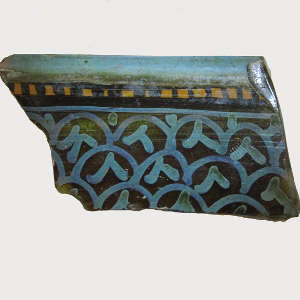Using AI to control energy for indoor agriculture
30 September 2024
Published online 28 August 2018
Analyses of trace elements in artefacts from 9th century Samarra, in Iraq, show a sophisticated production and regional trade of glass.

Museum für islamische Kunst / Staatliche Museen zu Berlin [www.smb-digital.de/eMuseumPlus]
Using mass spectrometry, researchers, including Nadine Schibille of the National Centre for Scientific Research in France, measured the levels of 58 trace elements in 265 well-dated glass artefacts from ninth century Samarra, selected from museum collections in Germany and England. The elements indicated the geographic origins of the raw materials used to make the glass.
The city of Samarra, about 125km north of Baghdad, is an important source of archaeological information on early Islamic art and architecture. It was famous for the glass walls in its palaces, but little was known about how the city’s glass objects were produced.
The investigations identified four distinct types of glass made from soda-rich plant ash (the residue left after plants are burned), as well as reused glass from an older Roman method of glassmaking using mineral soda, also known as natron.
The natron types of glass are characteristic of glass produced prior to Samarra’s establishment. The transition from the use of natron to plant ash in glassmaking is thought to have taken place toward the end of the eighth and early ninth century in the Levant and Egypt, for unknown reasons. The changes, however, corresponded with a eastward cultural shift, starting in the later Umayyad period (661–750 CE) and progressing with the foundation of Baghdad as the capital of the Abbasid Caliphate in 762 CE.
Schibille says the variations in the characteristics of the raw ingredients used to make the artefacts clearly reflect different technological strategies and geographical origins, and reveal economic and cultural interactions.
“Plant ash was more widely available, which might have contributed to the diversification of primary glass production sites. Chemically, plant ash potentially introduces all sorts of additional minor and trace elements compared to earlier natron, which is relatively pure,” Schibille says.
The main indication for local glass production in or around Samarra is the chemical homogeneity of the bulk of the architectural glass says Schibille.
Alastair Northedge of Pantheon-Sorbonne University in Paris, who was not involved in the study, says this research builds on previous work on the introduction of plant ash alkali glass into the Mediterranean in early medieval times, based on late 8th century glass from Raqqa in Syria.
“The novelty of this study lies in the evidence of the wide range of types of glass used at Samarra, including the import of old glass artefacts from Syria and Egypt,” he says.
doi:10.1038/nmiddleeast.2018.96
Schibille, N. et al. The glass walls of Samarra (Iraq): Ninth-century Abbasid glass production and imports. PLoS ONE. https://doi.org/10.1371/journal.pone.0201749 (2018).
Stay connected: